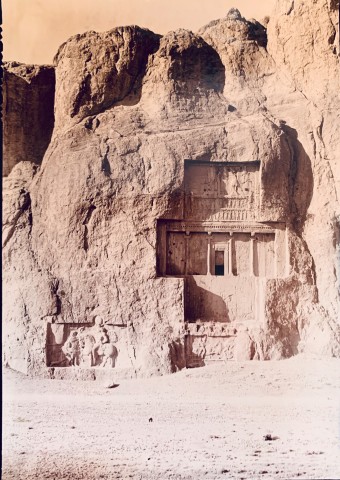Achaemenid Tomb of Darius I, Sasanian Reliefs Depicting the Triumph of Shapur I over Valerian, and Sasanian Reliefs Depicting the Equestrian Combat of King Bahram II above the Equestrian Combat of Bahram's Son, Naqsh-i Rustam, 1923-28
Gelatin silver print
140 mm x 184 mm
%3Cdiv%20class%3D%22artist%22%3E%3Cstrong%3EErnst%20Herzfeld%3C/strong%3E%3C/div%3E%3Cdiv%20class%3D%22title_and_year%22%3E%3Cem%3EAchaemenid%20Tomb%20of%20Darius%20I%2C%20Sasanian%20Reliefs%20Depicting%20the%20Triumph%20of%20Shapur%20I%20over%20Valerian%2C%20and%20Sasanian%20Reliefs%20Depicting%20the%20Equestrian%20Combat%20of%20King%20Bahram%20II%20above%20the%20Equestrian%20Combat%20of%20Bahram%27s%20Son%2C%20Naqsh-i%20Rustam%3C/em%3E%2C%20%3Cspan%20class%3D%22title_and_year_year%22%3E1923-28%3C/span%3E%3C/div%3E%3Cdiv%20class%3D%22medium%22%3EGelatin%20silver%20print%3C/div%3E%3Cdiv%20class%3D%22dimensions%22%3E140%20mm%20x%20184%20mm%3C/div%3E
'Ernst Herzfeld first visited Naqsh-i Rustam in November 1905 during his expedition return from the Assur (Kalat Schergat, Iraq) excavation. During the two last months of 1923 as well...
"Ernst Herzfeld first visited Naqsh-i Rustam in November 1905 during his expedition return from the Assur (Kalat Schergat, Iraq) excavation. During the two last months of 1923 as well as early March 1924, in addition of his work on the terrace of Persepolis, Herzfeld spent time at Naqsh-i Rustam checking the inscriptions. In 1928, the architect Friedrich Krefter joined Herzfeld in Persia, in an expedition funded by the Notgemeinschaft der Deutschen Wissenschaft, to complete various measured plans and drawings in Persepolis, Pasargadae, and Naqsh-i Rustam." Source: Freer Gallery of Art and Arthur M. Sackler Gallery Archives. Smithsonian Institution, Washington, D.C.
Literature
A glass negative of this image is located in the Ernst Herzfeld papers, Freer Gallery of Art and Arthur M. Sackler Gallery Archives, the Smithsonian Institution in Washington, D.C. The glass negative location number is FSA A.6 04.GN.1557.
